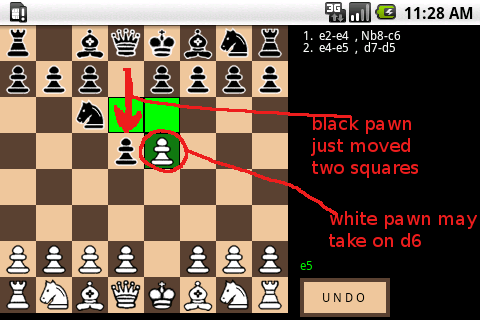

The general chess community's relative unfamiliarity with En Passant has turned "Google En Passant" into a catchphrase, particularly when a player is salty about losing to what they perceive is cheating. The move began making its way into memes when staff members of posted a humorous editorial explaining En Passant and lamenting the numerous reports they've received of players supposedly cheating or hacking by using the move. "En Passant" became a meme in the chess community in two ways. If Black chooses to not utilize En Passant on their turn, it's then off the table. This move can only be done on the turn following White's move forward two spaces. If all of these conditions are met, Black can capture the offending pawn by moving diagonally to the space the White pawn skipped. White takes one of its pawns, in a column next to the Black pawn's, and moves it forward two spaces, seemingly straight past the space where the Black pawn could normally capture it. Let's say Black has moved its pawn forward three spaces. "En Passant" can only happen under a specific set of circumstances. This is called " En Passant," and it's been flabbergasting even some veteran chess players for years. However, there's another, third way a pawn can move in a scenario so situational, it's practically a secret, and when it does occur, it looks like cheating. The only way a pawn can capture another piece is if that piece is diagonally in front of it. Pawns can only move forward one space at a time, or two if it's the first time they've moved in the game. The black Pawn captures on its diagonal and the white Pawn disappears from the board.Anyone with a basic knowledge of chess can tell you how pawns move. Here it's the black Pawn pretending that the white Pawn advanced a single square. The en passant option is now available to the black Pawn. This diagram shows a similar situation, except the white Pawn is now trying to run past the black Pawn. Of course, if Black had a Pawn sitting on its original square on the other column adjacent to the white Pawn, and if it also advanced two squares, the en passant option would appear on that side for the following move. If White makes another move, the option disappears. The en passant option is available to the white Pawn only on the move immediately following the black Pawn's bold attempt to run past the white Pawn. To capture en passant, the white Pawn moves as though it were capturing on its diagonal and the black Pawn disappears from the board. That would leave the black Pawn on a square subject to capture by the white Pawn. The white Pawn can now pretend that the black Pawn stopped on the square that is still marked by the green circle. This is the condition necessary for capturing 'en passant', also known as 'e.p.'. It looks like it has avoided being captured by the white Pawn. Now the black Pawn on the left has advanced two squares in a single move. In the next column is a white Pawn which also has the option to advance two squares. On the right side of the board, a black Pawn has advanced to its fifth row. According to the rules it has the option to advance one or two squares, as shown by the green circles. In the adjacent column is a black Pawn still on its initial square. On the left side of the board, a white Pawn has advanced to its fifth row.



When a Pawn tries to slip past an enemy Pawn, there's a special move.


 0 kommentar(er)
0 kommentar(er)
